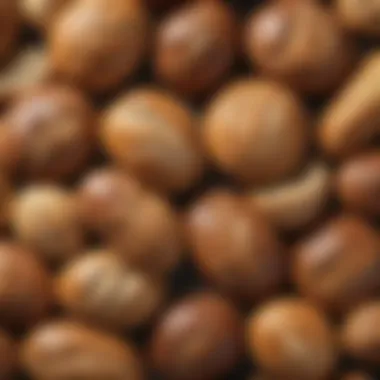Mastering Bread Maker Box Mixes: Your Ultimate Guide


Intro
Bread making has experienced a resurgence in recent years. Many people are turning to enjoy the simple pleasure of creating their own bread. Yet, the process can often feel overwhelming. This is where bread maker box mixes come in. They offer a convenient solution to those looking to bake bread at home, combining ease of use with the promise of satisfying results.
Bread maker box mixes come in various styles, catering to different tastes and dietary needs. They allow both novices and experienced bakers to explore complex flavors and textures with minimal effort. In this article, we will uncover the features and benefits of these mixes. We will also look closely at different types available, their nutritional profiles, and practical tips for successful bread production.
Understanding the nuances of bread maker box mixes can empower you in your baking journey. Whether you seek a quick meal solution or an elaborate homemade gift, these mixes provide the tools and ingredients necessary to achieve your goals. Let's dive deeper into the wonderful world of bread making using these convenient mixes.
Preface to Bread Maker Box Mixes
Bread maker box mixes represent a blend of convenience and culinary creativity. They have gained popularity due to their ease of use and the quality of bread they can produce at home. In an era where people seek to maximize efficiency in meal preparation, these mixes offer a straightforward solution for those wishing to bake fresh bread without extensive culinary skills.
Using a bread maker box mix allows even beginners to enjoy the process of baking. It eliminates the guesswork associated with measuring and blending ingredients. Just add water and any specific ingredients the mix directs. It opens up opportunities for exploration and experimentation with various bread types.
For many, the allure of freshly baked bread is a significant motivator. The scent that fills the kitchen while baking can evoke a sense of warmth and nostalgia. With the right mix, individuals can create a variety of breads, from traditional loaves to more contemporary recipes, all tailored to personal tastes.
However, there are some factors to consider. The quality of ingredients in these mixes can highly influence the final outcome. Therefore, understanding the specific mix, its components, and how it aligns with dietary preferences becomes essential. Being informed about bread maker box mixes enhances the baking experience and ensures that the bread produced meets taste and nutritional standards.
Bread maker box mixes offer the joy of homemade bread without the intensity of traditional baking methods.
In summary, these mixes allow bakers of all levels to achieve bakery-quality results in the comfort of their own homes. As we delve deeper into the specifics of bread maker box mixes, understanding both the definitions and the historical context will provide the foundation for fully appreciating their role in modern home baking.
Types of Bread Maker Box Mixes
Understanding the different types of bread maker box mixes is crucial for making informed choices in the bread-making process. Each mix offers unique flavors, textures, and nutritional profiles. By knowing about these various categories, bakers can select the mix that best suits their tastes and dietary needs. This knowledge enhances the overall experience and results in a more enjoyable homemade bread.
Traditional White Bread Mixes
Traditional white bread mixes are the cornerstone of many baking experiences. Made primarily from refined wheat flour, these mixes provide a consistent result that is soft, light, and versatile. They are ideal for sandwiches, toast, or as a base for various toppings. The simplicity of these mixes allows novice bakers to get started with confidence.
These mixes often contain added yeast and sometimes sugar, which helps the bread rise and develop a pleasing crust. However, it is important to note their lower nutritional value compared to whole grain alternatives. When selecting a traditional white bread mix, look for those with fewer additives to enhance bread quality and taste.
Whole Wheat and Multigrain Mixes
Whole wheat and multigrain mixes are a step towards healthier options. Whole wheat flour retains the germ and bran of the wheat, providing more fiber, vitamins, and minerals compared to refined flour. The rich nutty flavor and denser texture make these mixes suitable for heartier sandwiches or as standalone bread.
Multigrain mixes often incorporate a combination of different grains and seeds. They can include oats, barley, or flaxseed, adding extra nutrients and flavor dimensions. Both whole wheat and multigrain mixes appeal to health-conscious bakers looking for nutritious choices without sacrificing taste.
Gluten-Free Options
For those with gluten sensitivities or celiac disease, gluten-free box mixes are essential. These mixes use alternative flours, such as rice, almond, or coconut flour. They often include starches like tapioca to help achieve the desired texture. The taste can vary significantly, so it may require some experimentation to find a favorite brand or recipe.
When working with gluten-free breads, adjustments in baking time and technique may be necessary. It is also helpful to look for gluten-free mixes that include xanthan gum or other binding agents to improve the bread's structure and texture.
Specialty and Artisan Mixes
Specialty and artisan mixes cater to more adventurous bakers. They often feature unique flavors like rosemary, cheddar, or olive, allowing for more creative bread-making. These mixes may also include organic ingredients or be tailored towards specific dietary preferences, such as no preservatives or ancient grains.
Using these mixes can elevate the bread-making experience, transforming simple loaves into gourmet creations. Bakers can impress guests with bespoke flavors while enjoying a satisfying baking process. As tastes evolve, these artisanal mixes reflect current food trends, providing consumers a more diverse selection.
Understanding these types of bread maker box mixes can greatly enhance the baking experience. Each category brings its own advantages, flavor profiles, and health considerations into the mix. By selecting the right product, bakers can ensure they create the ideal loaf for any occasion.


Nutritional Aspects of Bread Maker Mixes
Understanding the nutritional aspects of bread maker box mixes is crucial for anyone looking to incorporate these products into their baking routines. This knowledge not only supports informed decision-making concerning health and diet, but also enhances the satisfaction of creating your own bread. Home bakers deserve clarity on what goes into their loaves, and this section delivers that insight by highlighting ingredients, nutritional profiles, and health considerations.
Understanding Ingredients and Labels
Ingredients in bread maker box mixes can vary substantially. Many mixes contain basic components like flour, yeast, sugar, and salt. However, some blends are enriched with additional ingredients such as vitamins, minerals, fats, and preservatives. Understanding these details involves scrutinizing product labels.
- Read the Label: Look for whole grain or whole wheat as the first ingredient for better fiber content.
- Avoid Unnecessary Additives: Artificial flavors and preservatives should be avoided if possible.
- Check for Allergens: Wheat, soy, or dairy may be present, exceeding suitable for some diets.
Knowing what each ingredient does is vital. For example, gluten is vital for bread structure, while fat can enhance flavor and moisture.
This awareness is essential when selecting mixes that fit your dietary needs. Understanding the labels helps to avoid mixes that might not align with your health goals.
Comparing Nutritional Profiles
Different bread maker box mixes can offer very different nutritional values, making it essential to compare these profiles. Here are some aspects to consider:
- Calories: A standard white bread mix might have around 150 calories per slice, whereas whole grain options may have significantly more due to fiber content.
- Fiber: Whole grain mixes often boast higher fiber levels, which is beneficial for digestion.
- Sugars and Salt: Bread mixes may contain added sugars or sodium which can affect health, especially in excess.
Always compare nutritional labels diligently. This practice can help you choose a mix with better health benefits.
Health Considerations for Different Diets
As diverse as diets are, bread maker mixes can cater to multiple preferences and needs:
- Gluten-Free Diets: For those with gluten intolerance, there are specific mixes that use alternative flours like rice or almond flour. These can provide a way to enjoy homemade bread without adverse effects.
- Low-Carb Diets: Some mixes offer reduced carbohydrate content, catering to those looking to minimize carb intake.
- Vegan Diets: Many commercially available mixes are free of animal products, making them suitable for vegans.
Nonetheless, it is essential to check each mix carefully. Some products claim to be healthy but might contain unwanted ingredients that conflict with specific dietary regulations. The balance between enjoyment and health is attainable, but it starts with being informed about your options.
How to Use Bread Maker Box Mixes
Using bread maker box mixes is a convenient way to create homemade bread with little effort. Understanding how to effectively use these mixes is crucial for achieving the best results. This section will detail the preparation steps, the importance of understanding your bread maker's settings, and will outline common mistakes to avoid.
Preparation Steps
Preparation is a vital stage in bread making. When utilizing a bread maker box mix, follow these essential steps:
- Read the Instructions: Begin by thoroughly reading the instructions on the box mix. Each brand may have unique guidelines for optimal results.
- Gather Your Ingredients: Aside from the box mix, you typically need water and sometimes additional ingredients, like oil or eggs. Measure these components accurately.
- Add Ingredients in the Correct Order: Generally, liquids should go in first, followed by the dry mix, and any additional items last. This order prevents clumping and ensures even mixing.
- Check Expiration Dates: Ensure that both the box mix and additional ingredients are fresh. This will affect the rise and texture of the bread.
Following these steps can lead to a great baking experience and a satisfactory loaf.
Understanding Bread Maker Settings
Every bread maker has its own distinct settings, which directly influence the baking process. Familiarizing yourself with these settings is integral:
- Crust Color: This setting determines how dark you want the crust. Options range from light to dark. Consider your preference carefully, as it changes the flavor and texture.
- Bread Type: Select the appropriate type, such as basic, whole wheat, gluten-free, or dough. Each setting addresses specific baking requirements.
- Size: Adjust the size based on how much bread you wish to make. Most machines offer options like 1.5 or 2-pound loaves.
Understanding these settings ensures you utilize your bread maker effectively, resulting in better-baked bread.
Common Mistakes to Avoid


Baking bread with box mixes can be simple, but several common mistakes can lead to disappointing results:
- Ignoring Instructions: Skipping steps or ignoring the specific instructions can lead to disappointing results. Always follow the recommended guidelines.
- Overloading the Machine: Adding too many additional ingredients or exceeding the maximum capacity can cause the machine to struggle. Adhere to the recommended amounts for the best outcome.
- Not Using Fresh Yeast or Ingredients: Ingredients losing their potency can drastically affect the bread's quality. Check freshness before use.
- Opening the Lid Prematurely: Opening the bread maker mid-cycle can impact the rising phase, leading to collapsed bread.
Avoiding these common pitfalls can significantly enhance your bread-making experience and lead to the satisfaction of enjoying a fresh loaf.
Enhancing Your Bread with Add-ins
Bread maker box mixes offer a convenient starting point for baking. However, the addition of specific ingredients can elevate the flavor and texture of the bread significantly. This section explores various add-ins that can personalize and enhance your bread-making experience. By incorporating these ingredients, bakers can create unique loaves tailored to their taste preferences, making each baking session a fun experiment.
Exploring Popular Add-ins
When enhancing bread made from a box mix, certain add-ins stand out due to their popularity and versatility. Some common choices include:
- Nuts: Walnuts, pecans, and almonds can add a delightful crunch and richness.
- Seeds: Flaxseeds, chia seeds, and sunflower seeds contribute both flavor and nutritional benefits.
- Fruits: Dried fruits like cranberries or apricots can provide a natural sweetness and chewy texture.
- Herbs: Fresh or dried herbs such as rosemary and thyme can give a rustic flair.
- Spices: Cinnamon, nutmeg, or garlic powder offer aromatic notes that can transform the bread's profile.
Incorporating these elements not only improves taste but also brings nutritional variety. For instance, adding nuts can boost omega-3 fatty acids, while dried fruits can increase fiber content.
Balancing Flavors and Textures
To achieve an appealing loaf, it’s crucial to balance flavors and textures effectively. Here are some considerations for doing that:
- Proportions: When adding ingredients, a good rule of thumb is to keep the total volume of add-ins to around 1/2 cup for a standard loaf. This ensures the structure of bread remains intact while enhancing its character.
- Compatibility: Think about how flavors combine. A sharp cheese might work well with herbs, while citrus zest pairs beautifully with sweet dried fruits.
- Texture Interaction: Consider how the add-ins change the bread's texture. Adding seeds can create a crunchy crust while fruits add chewiness.
Experimentation is critical. Don’t hesitate to try unconventional combinations until you discover a pairing that pleases your palate.
In summary, enhancing your bread with thoughtful add-ins allows for creativity and personalization. By introducing these vibrant ingredients, bakers can not only improve the taste but also explore new textures and flavors, making each loaf a distinctive culinary experience.
Troubleshooting Common Issues with Bread Maker Mixes
When using bread maker box mixes, it is essential to recognize potential problems. Understanding these issues enables bakers to create better bread and enjoy the process. A proactive approach to troubleshooting can enhance the baking experience while minimizing frustration.
Identifying Common Problems
Several issues can arise during the use of bread maker box mixes. Some common problems include:
- Dough Not Rising Properly: Insufficient rise can stem from expired yeast or incorrect measurements of ingredients.
- Dense Bread: This may result from too much flour or not enough liquid. A heavy loaf can also indicate that the bread maker's settings were not appropriate.
- Uneven Baking: If the loaf is not evenly cooked, it could be due to uneven distribution of ingredients or inadequate settings selected for the bread maker.
- Burnt Crust: A crust that is too dark or burnt might signal overly high baking temperatures or an extended baking time.
To effectively identify these issues, pay attention to the recipe notes on the box mix and ensure that you know how to adjust settings accordingly. Even the quality of your ingredients can impact the outcome.
Effective Solutions and Tips
Once you identify the issues, implementing targeted solutions is vital. Here are practical tips for each problem mentioned earlier:
- For Dough Not Rising Properly: Check the expiration date on the yeast and use it fresh. Ensure that you are measuring all ingredients accurately.
- To Fix Dense Bread: If the bread is too dense, consider using less flour in the recipe. The liquid-to-flour ratio is key, so feel free to adjust it slightly until you achieve the desired texture.
- For Even Baking: Ensure ingredients are mixed thoroughly in the bread pan. This can help distribute heat evenly. Adjust the baking color settings in the bread maker, if it is not operating as desired.
- To Prevent Burnt Crust: Use the light or medium crust setting if your machine has one. It may also help to adjust the cooking time based on how dark you prefer your crust.
Baking can be a learning experience. Overcoming challenges in this process ultimately leads to better results. Every baker should familiarize themselves with the bread maker's manual and ranges of temperature settings as well as ideal ingredient ratios.
"Baking bread is an art. Even with a mix, understanding your machine helps elevate the process."
Being detail-oriented can result in significant improvements. With careful observation and practice, many issues can be avoided altogether.


Environmental Impact and Sustainable Practices
The conversation around bread maker box mixes increasingly includes discussions about environmental impact and sustainable practices. As consumers become more aware of how their choices affect the planet, ensuring that bread maker box mixes align with these values is essential. This section looks into specific elements that contribute to a more sustainable bread-making process, emphasizing responsible sourcing of ingredients and thoughtful packaging.
Sourcing Ingredients Responsibly
Sourcing ingredients with care is crucial for minimizing negative environmental impact. Many bread maker box mixes contain a variety of elements. Flour, yeast, sugar, and additives vary significantly in sourcing practices. Opting for organic components, if possible, can reduce the reliance on chemical fertilizers and pesticides. It is also beneficial to look for local suppliers, raising awareness about seasonal ingredients and supporting local economies.
Products certified by the Rainforest Alliance or Fair Trade can further ensure that farming practices respect biodiversity and provide fair wages for farmers. The choice of grains also matters; whole grains typically require fewer resources to cultivate compared to highly processed counterparts.
Packaging Considerations
In addition to sourcing ingredients, how these products are packaged plays a significant role in sustainability. Bread maker box mixes often come in various materials, and choosing brands that use recyclable or biodegradable packaging can lessen waste. The rise of minimal packaging solutions reflects a growing trend in consumer preferences. Brands that embrace less packaging often find favor with environmentally conscious buyers.
"Sustainable packaging isn’t just a trend, it’s an expectation among modern consumers looking for accountability in their product choices."
By investigating the types of materials used, like plastics or cardboard, bakers can make informed decisions that align with their eco-friendly values. Furthermore, brands that promote reuse or refill options for their products are contributing positively to a sustainable future.
In summary, when making bread at home using box mixes, consumers can significantly impact sustainability. Awareness around responsible sourcing and packaging can lead to choices that prioritize both quality and the environment.
Cost-Benefit Analysis of Bread Maker Box Mixes
Understanding the cost-benefit analysis of bread maker box mixes sheds light on their value in home baking. It is vital for both novice bakers and experienced ones to consider the expenses involved in using box mixes compared to traditional bread-making methods. This analysis helps to identify convenience, quality, and potential savings over time.
Comparing Costs with Homemade Bread
When comparing the cost of bread maker box mixes with homemade bread, several factors need to be examined. Given the rising costs of ingredients and time required for traditional bread-making, box mixes often present an appealing alternative.
- Ingredient Costs: Box mixes come with pre-measured ingredients, which eliminates waste from unused products. When baking from scratch, certain items may need to be purchased in bulk, leading to higher initial expenses even if they are used repeatedly.
- Time Efficiency: Making bread from scratch can take several hours. A box mix simplifies this process, allowing a loaf of bread to be prepared in about two hours. Thus, the time saved can be viewed as a cost-saving factor, especially for busy individuals.
- Energy Consumption: Using a bread machine may use less energy compared to heating an oven, particularly for smaller batches. This efficiency can reduce utility bills, further tipping the scales in favor of box mixes.
Long-term Savings and Investments
In the long run, bread maker box mixes can lead to significant savings when considered as an investment in home cooking.
- Quality vs. Quantity: Box mixes can produce quality bread consistently. The cost per loaf can often be lower than that of store-bought artisan breads made with high-quality ingredients. Over time, making high-quality bread at home can reduce the overall expenditure on premium baked goods.
- Reduced Food Waste: Consistency in portion sizes and handling reduces the risk of making too much bread, which can lead to waste. Leftovers can be creatively used in other dishes, which maximizes value from the ingredients.
- Health and Nutrition: By choosing or creating specific box mixes, consumers can control ingredients, avoiding preservatives that are common in commercial breads. This might save money on healthcare costs associated with diet-related issues.
"Investing in a good bread maker and box mixes is not merely about baking; it's about enhancing culinary experiences and promoting healthier eating habits."
With careful consideration of costs and long-term benefits, it is clear that bread maker box mixes offer a balance of convenience and quality. Informed decisions based on a thorough cost-benefit analysis can enrich not just the baking experience but also overall cooking practices.
Future Trends in Bread Making and Box Mixes
Exploring future trends in bread making and box mixes is essential for both consumers and producers. The landscape of food preparation is constantly evolving, with innovations in flavors, techniques, and technology. As more people turn to home baking for both satisfaction and health benefits, understanding these upcoming trends can enhance their experience and results. Additionally, businesses must adapt to consumer preferences, which increasingly lean towards quality, sustainability, and convenience. By recognizing these trends, bakers can create exciting, contemporary bread that meets the needs of today's diverse markets.
Innovative Flavors and Techniques
The world of bread making is no longer limited to traditional recipes. There is a noticeable shift toward more daring and inventive flavors. Consumers are eager to explore unique combinations that go beyond basil and sun-dried tomato. Some innovative ideas include:
- Herbed Focaccia: Integrating fresh herbs like rosemary or thyme directly into the mix adds depth.
- Sweet Variations: Ingredients such as chocolate, dried fruits, or nuts can transform a standard recipe into a dessert-like indulgence.
- International Influences: Inspired by global cuisines, flavors from places like India or the Mediterranean are being incorporated into bread mixes.
- Fermented Ingredients: Using starters and fermented grains can provide a rich, tangy flavor.
These evolving preferences reflect a growing desire for personalization in bread making, allowing bakers to tailor their creations to specific tastes. Exploring these flavors not only elevates the bread-making experience but also promotes culinary creativity.
Technological Advances in Bread Making
As technology continues to advance, the bread making process is becoming more streamlined and user-friendly. Innovations in machinery and ingredients are paving the way for better bread quality and accessibility. Notable advancements include:
- Smart Bread Makers: New machines feature programmable settings with apps that let users customize baking parameters from their smartphones.
- Ingredient Innovation: Development of high-quality pre-mixed products allows even novice bakers to achieve professional results.
- Sustainability Technologies: Advances in sustainable packaging and sourcing of ingredients are aiding in environmentally responsible baking.
- Precision Baking Tools: Gadgets such as digital scales, thermometers, and even designed mixing containers can improve accuracy in the baking process.
These developments simplify the baking process, making it more accessible. With proper knowledge, bakers can leverage these technologies to produce high-quality bread that meets their expectations. As trends evolve, it will become increasingly important for bread makers to stay ahead of these changes to remain competitive and meet the demands of the market.







